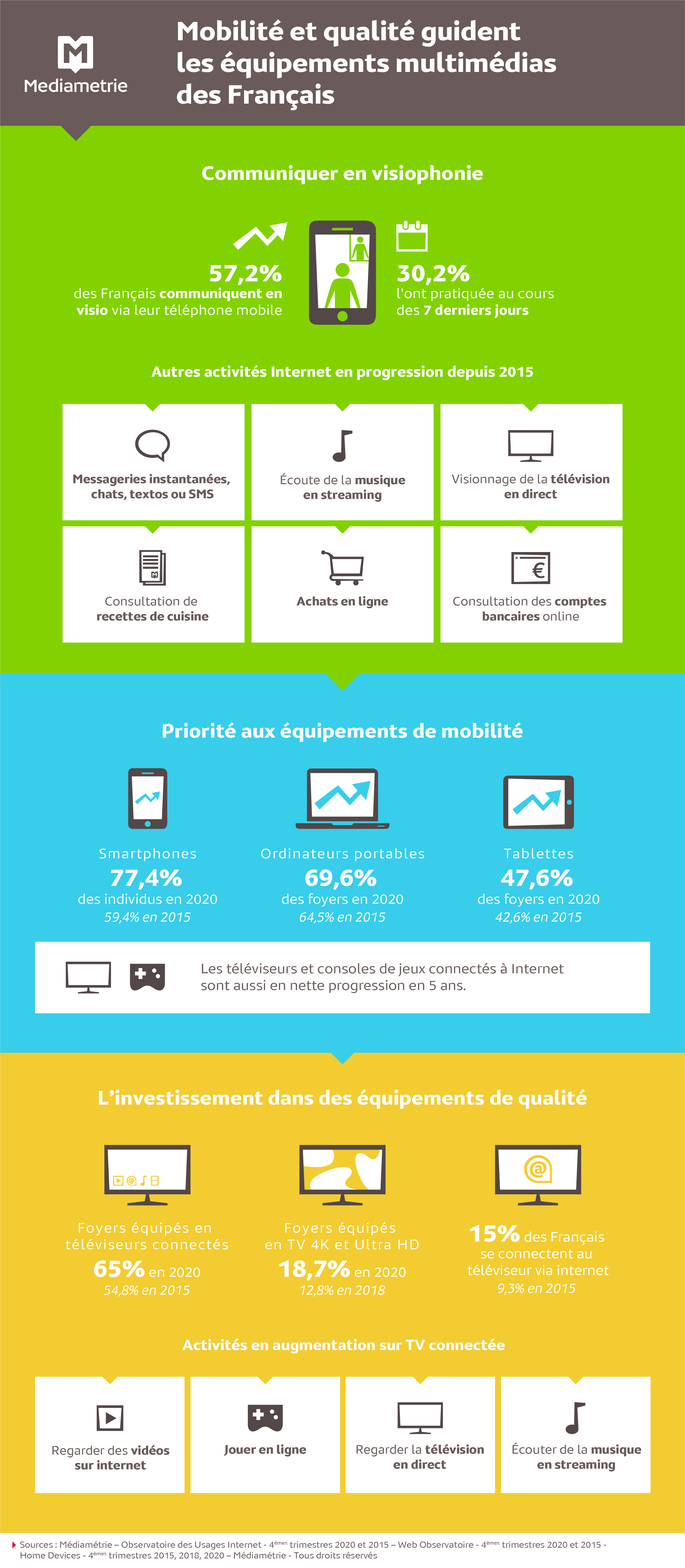- Home
- Results & Studies
- Nearly 6 out of 10 French people make video calls on their mobile phones
Nearly 6 out of 10 French people make video calls on their mobile phones

French people have adopted “video” communication on mobile phones, a phenomenon which has experienced strong growth, especially since the health crisis. This practice is notably facilitated by the progress of smartphone equipment, as well as by the widespread use of this feature by all manufacturers. The French are very fond of mobile devices connected to the Internet. At the same time, they are increasingly seeking quality from digital equipment. Médiamétrie detects and analyses the growing use of digital media in France.
“Video” calls
French people are now increasingly using video calls to communicate, whether for personal or professional reasons. This system, which allows 2 (or more) people to see each other during a telephone conversation, has seen its use increase considerably in 5 years: nearly 6 out of 10 French people (57.2%) used it in the 4th quarter of 2020[i], whereas this figure stood at 18% in 2015. As Charlotte Leboucher, Study Director at Médiamétrie’s Consumer Insight Department, says “this acceleration is linked to widespread homeworking, distance learning courses and the different lockdown periods inherent in the health crisis. Students, 16-34-year-olds, people in the upper SPC and households with child(ren) aged under 15 are the groups that use it the most.”
The use of videos on mobile phones is increasing, but so is the frequency of use: almost one out of 3 French people (30.2%) connected over the phone via video over the previous 7 days, which is almost 24 points more than for the same period in 2015
Beyond video, the progress of which has been spectacular, in general, communication activities have made great progress on the internet over the past 5 years: this is particularly the case of instant messaging.
While communication occupies an ever more place on the Internet, online leisure and media are also popular among French Internet users.
Some of the online activities that have progressed the most are streaming music, watching live TV and checking cooking recipes. The same is true for practical activities: making a purchase or checking bank accounts online.
Conversely, and in line with the current health crisis, Médiamétrie has seen a reduction in some online activities over the last year, such as searching for routes or maps, consulting practical information or booking hotels and restaurants.

Priority to mobile equipment
Charlotte Leboucher says: “The increase in these online uses is particularly linked to the nature of digital devices possessed. Indeed, although each household has 6.5 screens on average (a figure that has been stable for 5 years), French people now primarily favour equipment promoting mobility.”
In first place is the smartphone, which experienced the biggest increase: in the fourth quarter of 2020, more than 3 out of 4 people (77.4%) owned one; less than 2 in 3 people (58%) had one at the end of 20151.
Households have also invested in laptops, which are now widespread: almost 7 out of 10 households had one in 2020, up from 64.6% in 2015[ii]. This increase has been at the expense of desktop computers.
French people keep buying tablets: nearly one in two households now have one (47.6%). In 2015, 42.6% of French households had a tablet. The number of households with more than one tablet also increased slightly.
Households mainly use laptops and tablets when moving around the home itself.
In addition to mobility, French households have increased their connected equipment: televisions and game consoles connected to the Internet have also made major progress over 5 years.
Investing in quality equipment
Alongside the practical dimension and accessible at any time nature of mobile equipment, there is a fundamental trend in the search for comfort and quality.
The use of connected televisions has thus increased sharply: nearly 2 out of 3 households had one (65%) compared to 54.8% in 2015. In order to access better image resolution, French households are buying more recent 4K or Ultra HD TV sets: nearly 2 out of 5 (18.7%) households had them in 2020, compared to 12.8% in 20182.
With the development of the ergonomics and capacities of TV sets, more and more Internet users are using them to connect to the Internet: this is the case for 15% of French people. Only 9.3% of French people did this in 2015. In addition to watching live television, some activities are on the rise on connected TVs, including watching videos on the Internet, streaming music and online gaming.
“The evolution of the equipment of French people in the last 5 years therefore reflects two complementary trends: both a need for mobile tools, favourable to individual use within or outside the home, whether for communication, work, e-commerce, gaming, etc. And at the same time, people are looking for quality, particularly with videos, in a more collective practice, which is associated with relaxation and sharing”, concludes Charlotte Leboucher.
des médias
edition
definitions